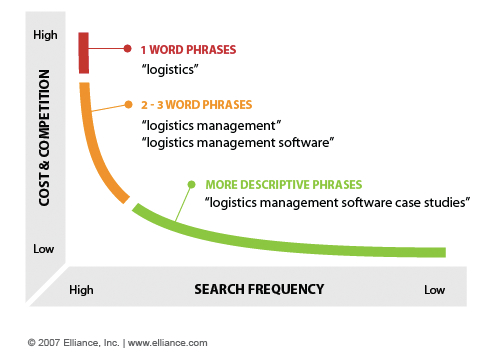Best of both worlds: How to create a long-tail SEO strategy for social media micro-content
ver find it difficult to rank for relevant keywords in search or gain traction on social? Most marketers have faced the challenge of getting their business to stand out amongst the chatter.
It’s a marketer’s job to really understand how each advertising channel can benefit their organization in better reaching their audience on a regular basis.
Optimizing for the search engines has long been a way of driving qualified traffic to a company’s website, in many cases it is often the number one source.
With the increasing domination of social media in the marketing industry, there’s been a growing change in the focus of marketers split amongst a few channels mainly search engine optimization and social media marketing.
 (Source: Volusion)
(Source: Volusion)
Since both marketing channels are widely used by marketers across verticals, it’s important to have your efforts drive results while also cutting through the extensive competition.
In order to see both short-term and long-term results from your marketing, create micro content on a regular basis for your social channels in order to emulate the results typically seen from long-tail SEO.
Long-tail SEO vs. Social micro-content
Focusing on the long-tail keywords for your SEO campaigns is a proven tactic for driving long-term results for your business.
It’s ideal for most businesses to go after multiple longer keywords phrases for their SEO as opposed shorter or one word keyword phrases that are more highly competitive and will take much longer to gain traction with.
Long-tail have a higher overall organic click-through rates with 56 pecent of searches for phrases of four words, while single-word search queries only have a 30 percent click-through rate.
It’s similar to the newer idea of focusing on publishing multiple smaller pieces of content for sharing on social media as opposed to spending too much time or resources on any one post on Facebook, Instagram, Twitter, Vine or elsewhere.
Many businesses worry about making the next perfect viral post for their Facebook page or elsewhere, when it should just be one part of an extensive strategy to consistently educate, entertain and excite your audience about your brand on a regular basis.
 (Source: Elliance)
(Source: Elliance)
Just like centering your strategy for success with SEO on long-tail keywords that pay off in the long-term, also focus on creating many micro-moments of social success that help your brand build a meaningful relationship with your business overtime with each and every post across channels.
The big difference between these two approaches is that they require unique tactics to achieve similar results in the long-term.
When working on your SEO strategy it requires focusing on the use of the right keyword phrases across your website and in your content, both long-form and short-form content creation, optimizing your on-page factors as well as site usability and off-page optimizations like building a variety of links with different anchor text to your website.
The process of developing ongoing micro-content requires consistent creation of quality images, copy, long-form content, videos, tweets and more to fuel each of your active social channels on a regular basis.
Not to mention, its essential to create content focused on the right subjects related to your business offerings and the interests of your audience that are distributed at the right times and on the appropriate channels.
Long-term benefits of both approaches
Both approaches to being a smarter marketer are beneficial to your business because they allow your organization to get its messaging through to your audience ahead of the competition at a quicker pace than if you were to focus too heavily on achieving short term gains.
Focusing your efforts on long-tail SEO works because the phrases you’re trying to optimize your website for are more specific and therefore, likely to drive relevant visitors and revenue.
These phrases are not as competitive since they are so specific to a niche of an industry, it’s far more likely that your website will rank highly for these key phrases overtime.
Even though one or two more competitive keyword phrases can drive lots of traffic, it isn’t likely relevant enough to make up for the smaller, yet more qualified traffic multiple long-tail keyword phrases drive.
Therefore, long-tail SEO tactics are more likely to drive more relevant traffic to your website since these key phrases are more catered to your business offerings and far less competitive than one to two word keyword phrases.
It’s hard to tell when your SEO efforts will pay off, but likely in three months to a year will you see results from working on optimizing for multiple keyword phrases.
Similarly, creating consistent micro-content on behalf of your business will work to create a strong memory of what value your business offers to its customers on a regular basis.
Making each of your social account’s a consistent and engaging experience for your audience will help associate your business as an expert in your industry since you’ve positioned yourself overtime as a reliable source of information on certain topics.
(Source: Statista)
The biggest benefit of micro-content like a tweet, a Vine, an Instagram, a Facebook post etc. is the fact that it doesn’t have to take a lot of investment to create each piece of content, as long as each is consistent and covering topics related to your company and it’s audience’s interests.
A person’s attention span is limited to about eight seconds online according to Visage, so spending too much time on any one piece of micro-content isn’t worth the investment as compared to having many consistent little wins that a person remembers due to the right balance of publishing overtime.
How to execute a healthy balance of long-tail and micro-content
It’s possible for your business to execute against both long-tail SEO and social micro-content at once by creating a plan of action that keeps both concerns in mind, while driving worthwhile results for the long-term success of your business.
Here are three steps to executing a long-term plan for smarter marketing for your business:
1. Create In-Depth Content: Content fuels both the search engines and social media, create compelling content like blog posts, videos, infographics and more that will exist on your web properties, but will also be able to live in some capacity on your social channels as well.
For example, create a blog post on your website that is optimized with the right long-tail keyword phrases and then create a Facebook post, tweets and other social micro-content about it to fuel both marketing channels appropriately.
 (Source: Netline)
(Source: Netline)
2. Synch the Long-Tail Keyword Phrases Across Content: When creating content make sure you’re optimizing for a few dozen long-tail keyword phrases to best suit your efforts on the search engines that are also coordinated with micro-content shared on social.
You’ll see the best traction from both efforts if you’re optimizing for various keyword phrases that fall under a few different topic areas. This is the case since you’ll be sharing a variety of consistent content on social to keep the interest of your audience, while capturing the traffic generated from different searches across your customer base.
3. Continue to Scale Your Content Creation: According to Marketing Charts, 90 percent of marketers today use content marketing to reach their audience. One of the keys to successful content marketing is a continual increase of the amount of quality content you’re producing on a regular basis.
Both approaches to marketing smartly require that you scale content while retaining the quality of that content to continue to remain competitive with the right keyword phrases in search, while remaining heard amongst the chatter on your active social channels.
What do you think about the comparison between long-tail SEO and micro-social content? What tactics is your company using to get your messaging across to your customer base? Sound off in the comments below.
